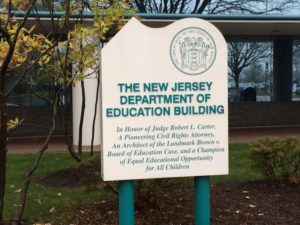When I talk about how much money Newark Public Schools spends each year, people are surprised. How, they ask, can a district that serves 55,000 students (20,000 in public charters) spend $1.2 billion for a year’s worth of education?
I usually begin my answer with this fact: Newark is REALLY top-heavy. This means that the district behaves like a corporation that hires way too many managers compared to the number of people they supervise. This not only costs taxpayers more money than a leaner organization through unnecessary overhead, but also leads to communication problems: we’re that many more levels away from the real decision-makers.
How do I know this fact is true?
It’s all there in a New Jersey Department of Education database called Taxpayer’s Guide to Education Spending.
Here’s an example. One of the items of information on this site–they’re called “Indicators”—is #18, the “Ratio of Students to Administrative Personnel and Median Salary.” Administrative personnel are principals, assistant principals, Central Office staff, supervisors. Across the state, school districts average 135 students for every administrator.
Except for Newark. Here, we average one administrator for every 84 students. That’s almost twice as many administrators per student as the state average!
Yes, but Newark is different, people say, we’re the biggest district in the state serving atypically needy students, many low-income. We need more administrators than a typical district.
Luckily the Taxpayers Guide accounts for this comparability problem by dividing districts into “peer groups,” districts with similar demographics and student needs. There are 91 districts in Newark’s peer group.
Question: How do we compare with similar districts regarding administrative overhead?
Answer: We’re #1 in our peer group, rated 91 out of 91. Newark has the lowest ratio of students to administrators than any other similar district in the state and other large urban districts get by with many fewer administrators. For instance, Jersey City, NJ’s second largest district, has 184 students for every administrator, Elizabeth has 142 students per administrator, and Paterson has 123.
What do those districts know that we don’t?
Now let’s look at Indicator #19, the “Ratio of Faculty to Administrative Personnel.” Maybe we’re compensating for an overabundance of administrators to students by making them responsible for oversight of more teachers.
Nope.
The average New Jersey school district uses one administrator to supervise 15 teachers. In Newark, one administrator supervises only 7.7 teachers. In other words, our administrators supervise half as many teachers as other districts. Once again, we’re top in our peer group, 91 out of 91. Jersey City, to pick the most appropriate comparison, has one administrator supervising 18 teachers, more than twice as many as in Newark Public Schools.
Why should you care? After all, we do even things out a bit by having one of the lowest median salaries for administrators in the state: $111,500, according to the Taxpayer’s Guide, second lowest in our peer group.
But this low salary is simply a symptom of our larger problem of mismanagement. There are only two reasons the median pay is so low: 1) because our administrators don’t stick around to get their salary increases (remember, Newark pays very well: in June the School Board approved a contract with the teachers union that pays first-year teachers $62,000 a year); or 2) our administrators can’t get hired anywhere else and, maybe, aren’t capable of properly overseeing the typical number of staff and students.
This revelation points to fundamental mismanagement and misuse of taxpayer funds. Remember how Superintendent Roger Leon spent federal emergency COVID relief money on floor-polishers and inspirational videos?
Where does our money go? It’s definitely not going to our kids. Isn’t this why the State originally took us over? Has nothing changed?
I’ll keep digging until I get answers.





